engine LEXUS LS430 2006 Workshop Manual
[x] Cancel search | Manufacturer: LEXUS, Model Year: 2006, Model line: LS430, Model: LEXUS LS430 2006Pages: 419, PDF Size: 11.19 MB
Page 274 of 419
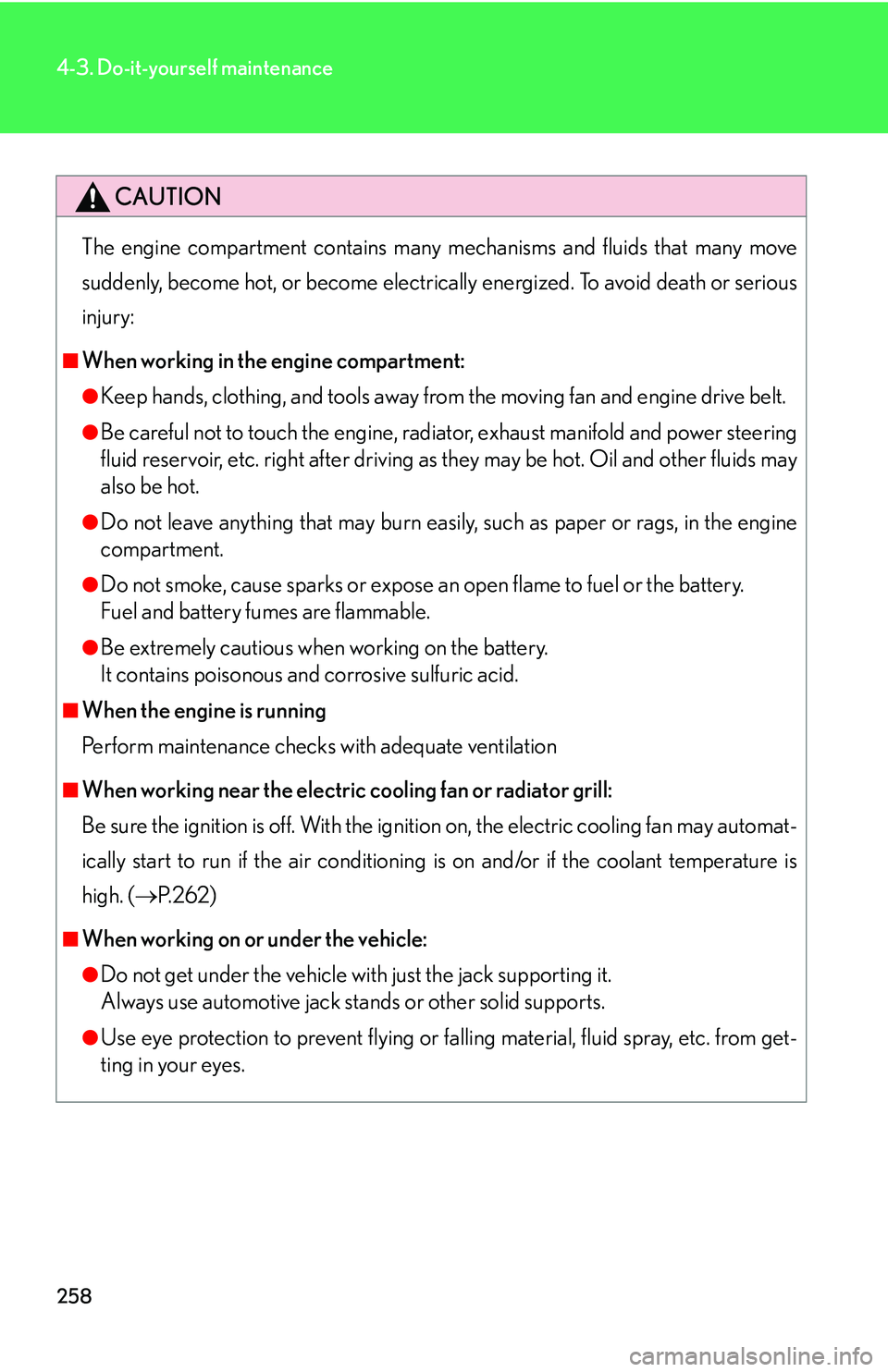
258
4-3. Do-it-yourself maintenance
CAUTION
The engine compartment contains many mechanisms and fluids that many move
suddenly, become hot, or become electrically energized. To avoid death or serious
injury:
■When working in the engine compartment:
●Keep hands, clothing, and tools away from the moving fan and engine drive belt.
●Be careful not to touch the engine, radiator, exhaust manifold and power steering
fluid reservoir, etc. right after driving as they may be hot. Oil and other fluids may
also be hot.
●Do not leave anything that may burn easily , such as paper or rags, in the engine
compartment.
●Do not smoke, cause sparks or expose an open flame to fuel or the battery.
Fuel and battery fumes are flammable.
●Be extremely cautious when working on the battery.
It contains poisonous and corrosive sulfuric acid.
■When the engine is running
Perform maintenance checks with adequate ventilation
■When working near the electric cooling fan or radiator grill:
Be sure the ignition is off. With the igni tion on, th
e electric cooling fan may automat-
ically start to run if the air conditioning is on and/
or if the coolant temperature is
high. ( P.262 )
■When working on or under the vehicle:
●Do not get under the vehicle with just the jack supporting it.
Always use automotive jack stands or other solid supports.
●Use eye protection to prevent flying or falling material, fluid spray, etc. from get -
ting in your eyes.
Page 275 of 419

259
4-3. Do-it-yourself maintenance
4
Maintenance and care
NOTICE
■If you remove the engine air filter:
Driving with the engine air filter removed may cause e
xcessive engine wear due to
dirt in the air.
Also, a backfire could cause a fire in the engine compartment.
Page 276 of 419
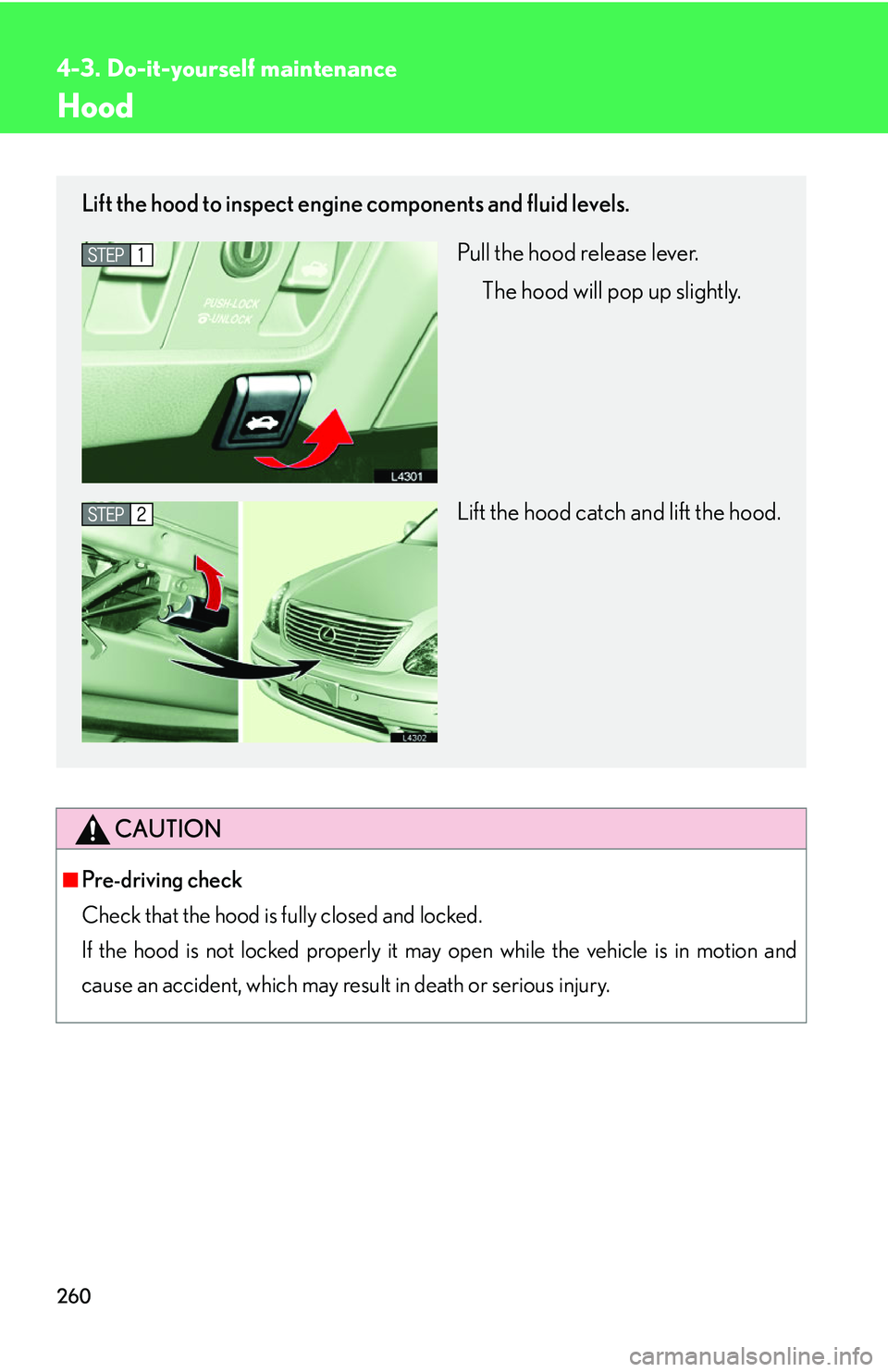
260
4-3. Do-it-yourself maintenance
Hood
CAUTION
■Pre-driving check
Check that the hood is fully closed and locked.
If the hood is not locked properly it may open while the vehicle is in motion and
ca
use an accident, which may result in death or serious injury.
Lift the hood to inspect engine components and fluid levels.
Pull the hood release lever.
The hood will pop up slightly.
Lift the hood catch and lift the hood.
Page 277 of 419

261
4-3. Do-it-yourself maintenance
4
Maintenance and care
Positioning the jack
CAUTION
■When raising your vehicle:
Make sure to observe the following to reduce the possibility of death or serious
injur
y.
• Do not put any part of your body or get underneath the vehicle supported only b
y the jack. Always use automotive jack stands or a solid, level, surface.
• Do not start or run the engine while your vehicle is supported by the jack.
• Stop the vehicle on level firm ground, firmly
set the parking brake and put the
selector lever in “P” position.
• Make sure to set the jack properly at the jack point.
Raising the vehicle with an improperly positioned jack will damage the vehicle
or
may allow the vehicle to fall off the jack.
• Do not raise the vehicle with someone in the vehicle.
• When raising the vehicle, do not place an y ob
jects on top of or underneath the
jack.
When raising your vehicle, position the jack correctly.
Improper placement may damage your vehicle or cause injury.
Dummy
Page 278 of 419
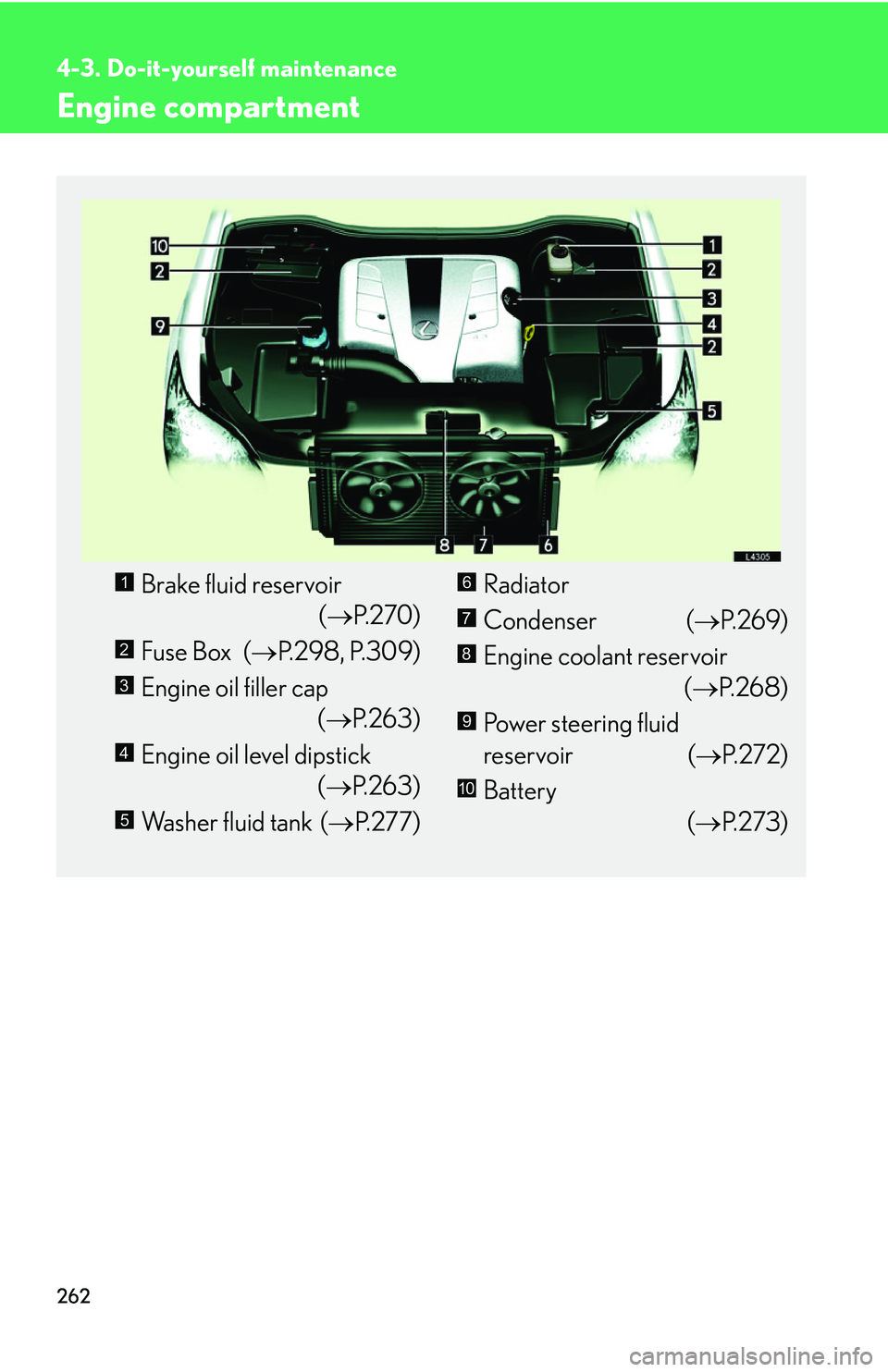
262
4-3. Do-it-yourself maintenance
Engine compartment
Brake fluid reservoir
( P.
2 7 0 )
Fuse Box ( P.298 , P.309 )
Engine oil filler cap
( P.
2 6 3 )
Engine oil level dipstick
( P.
2 6 3 )
Washer fluid tank ( P.277 ) Radiator
Condenser
(P.
2 6 9 )
Engine coolant reservoir
( P.
2 6 8 )
Power steering fluid
reservoir ( P
.272)
Battery
(P.
2 7 3 )
1
2
3
4
5
6
7
8
9
10
Page 279 of 419
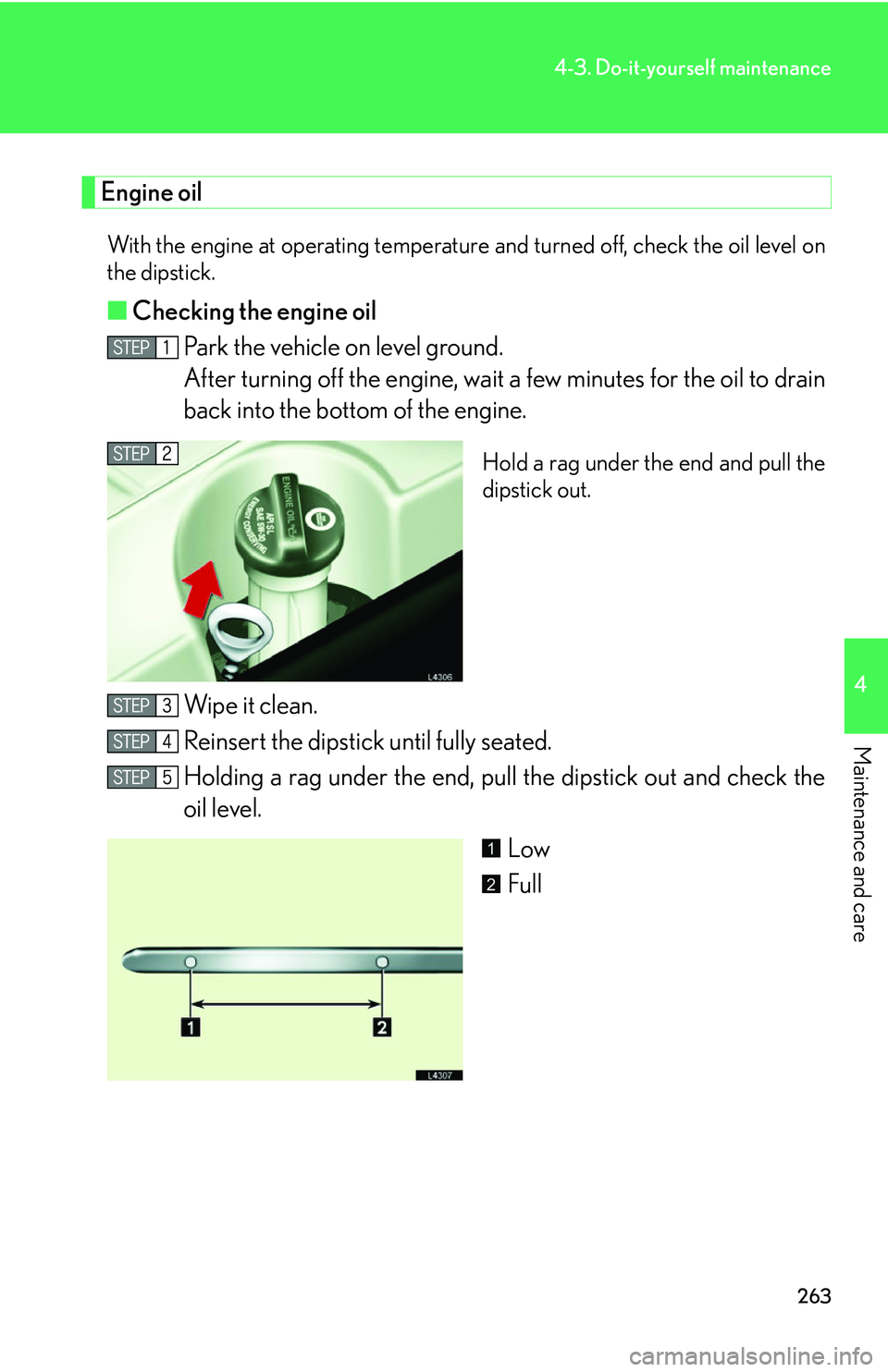
263
4-3. Do-it-yourself maintenance
4
Maintenance and care
Engine oil
With the engine at operating temperature and turned off, check the oil level on
the dipstick.
■ Checking the engine oil
Park the vehicle on level ground.
After turning off the engine, wait a few minutes for the oil to drain
back into the bottom of the engine.
Hold a rag under the end and pull the
dipstick out.
Wipe it clean.
Reinsert the dipstick until fully seated.
Holding a rag under the end, pull the dipstick out and check the
oil level.
Low
Full
1
2
Page 280 of 419
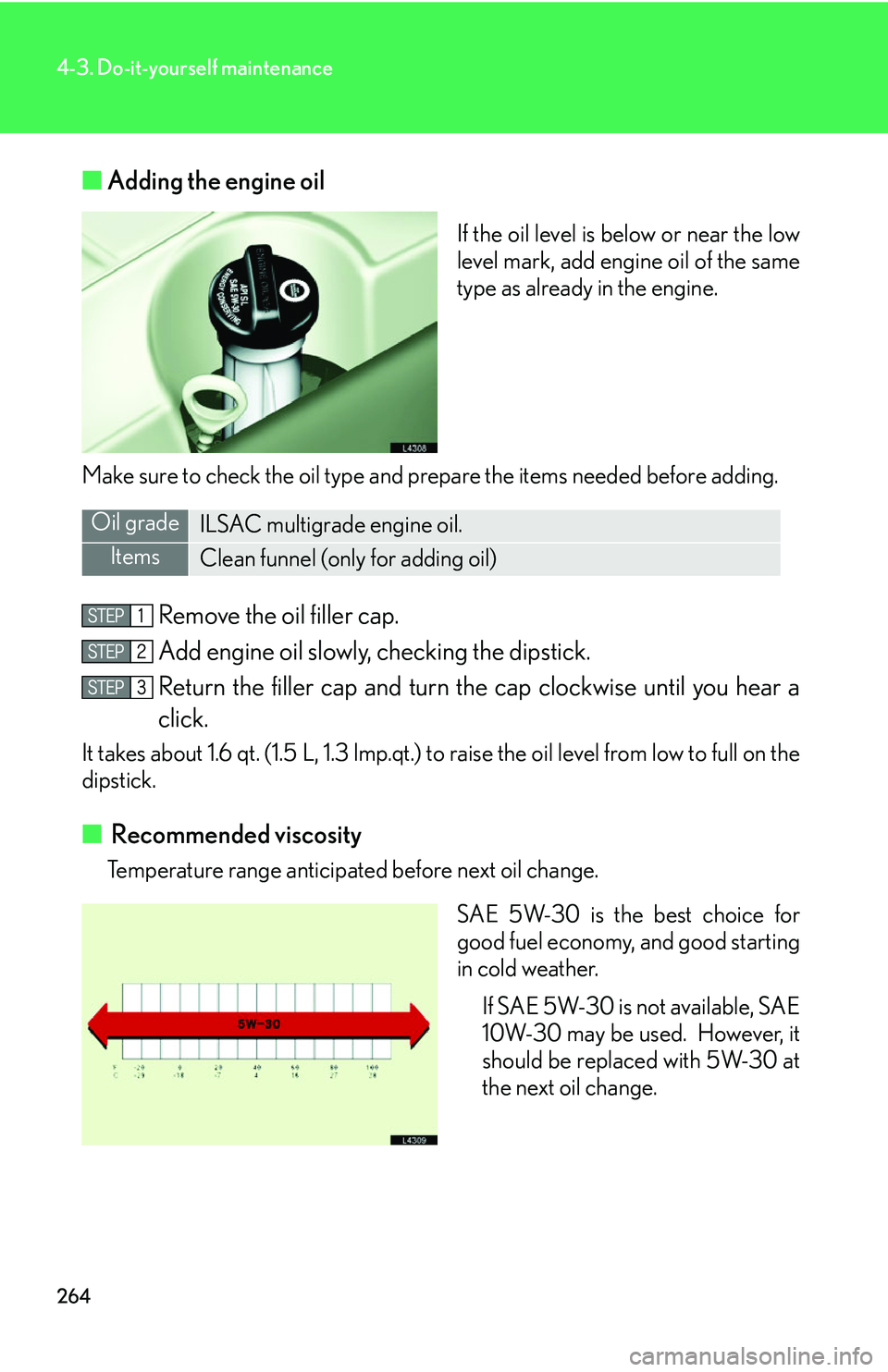
264
4-3. Do-it-yourself maintenance
■Adding the engine oil
If the oil level is below or near the low
level mark, add engine oil of the same
type as already in the engine.
Make sure to check the oil type and prepare the items needed before adding.
Remove the oil filler cap.
Add engine oil slowly, checking the dipstick.
Return the filler cap and turn the ca
p clockwise until you hear a
click.
It takes about 1.6 qt. (1.5 L, 1.3 lmp.qt.) to raise the oil level from low to full on the
dipstick.
■ Recommended viscosity
Temperature range anticipated before next oil change.
SAE 5W-30 is the best choice for
goo
d fuel economy, and good starting
in cold weather.
If SAE 5W-30 is not available, SAE
1
0W-30 may be used. However, it
should be replaced with 5W-30 at
the next oil change.
Dummy
Oil gradeILSAC multigrade engine oil.
ItemsClean funnel (only for adding oil)
Page 281 of 419

265
4-3. Do-it-yourself maintenance
4
Maintenance and care
■ How to read oil container labels
The ILSAC (International Lubricant Standardization and approval Commit -
tee) Certification mark is are added to some oil
containers to help you select
the oil you should use.
ILSAC Certification Mark
■Resetting the engine oil maintenance information data (U.S.A. only)
After replacing the engine oil, be sure to
reset the maintenance data. Otherwise,
the engine oil maintenance information may not function correctly. ( P.334 )
Push the "TRIP" button to change t
he trip meter display to blank.
Turn the ignition switch off.
Turn the ignition switch to "ON" while pushing
the trip meter "RESET"
button.
Keep pushing the trip meter "RESET " button for lon
ger than 5 seconds.
"Mileage Reset" appears on
the display, the master warning light comes
on, and a warning tone sounds.
Page 282 of 419
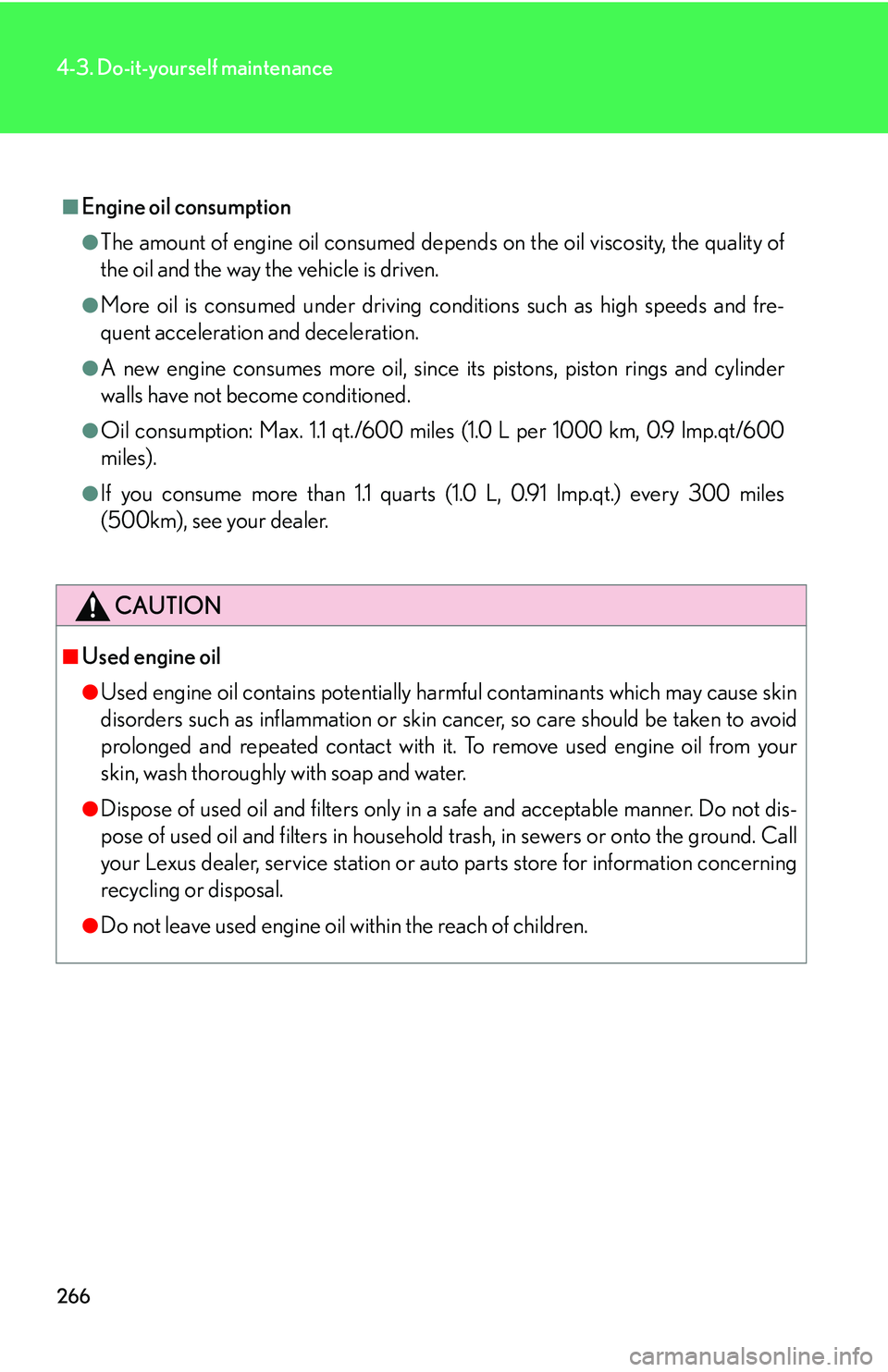
266
4-3. Do-it-yourself maintenance
■Engine oil consumption
●The amount of engine oil consumed depends on the oil viscosity, the quality of
the oil and the way the vehicle is driven.
●More oil is consumed under driving conditions such as high speeds and fre -
quent acceleration and deceleration.
●A new engine consumes more oil, since its pistons, piston rings and cylinder
walls have not become conditioned.
●Oil consumption: Max. 1. 1 qt./600 miles (1.0 L per 1000 km, 0.9 lmp.qt/600
miles).
●If you consume more than 1.1 quarts (1.0 L, 0.91 lmp.qt.) every 300 miles
(500km), see your dealer.
CAUTION
■Used engine oil
●Used engine oil contains potentially harmful contaminants which may cause skin
disorders such as inflammati on or skin cancer, so care should be taken to avoid
prolonged and repeated contact with it. To remove used engine oil from your
skin, wash thoroughly with soap and water.
●Dispose of used oil and filters only in a safe and acceptable manner. Do not dis -
pose of used oil and filters in household trash, in sewers or onto the ground. Call
y
our Lexus dealer, service station or auto parts store for information concerning
recycling or disposal.
●Do not leave used engine oil within the reach of children.
Page 283 of 419

267
4-3. Do-it-yourself maintenance
4
Maintenance and care
NOTICE
■To prevent serious engine damage
Check the oil level regularly.
■When replacing the engine oil
●Be careful not to spill engine oil on the vehicle components.
●Avoid overfilling, or the engine could be damaged.
●Check the oil level on the dipstick every time you refill the vehicle.
●Be sure the engine cap is properly retightened.